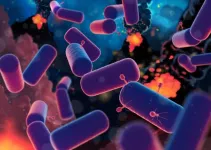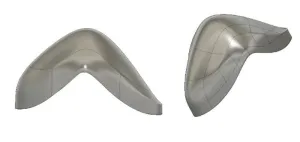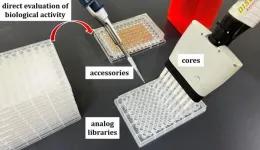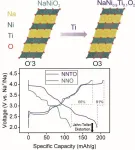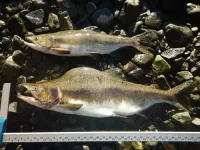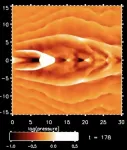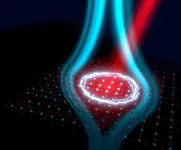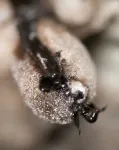(Press-News.org) An international team of researchers led by the University of Bristol has shed light on Earth’s earliest ecosystem, showing that within a few hundred million years of planetary formation, life on Earth was already flourishing.
Everything alive today derives from a single common ancestor known affectionately as LUCA (Last Universal Common Ancestor).
LUCA is the hypothesized common ancestor from which all modern cellular life, from single celled organisms like bacteria to the gigantic redwood trees (as well as us humans) descend. LUCA represents the root of the tree of life before it splits into the groups, recognised today, Bacteria, Archaea and Eukarya. Modern life evolved from LUCA from various different sources: the same amino acids used to build proteins in all cellular organisms, the shared energy currency (ATP), the presence of cellular machinery like the ribosome and others associated with making proteins from the information stored in DNA, and even the fact that all cellular life uses DNA itself as a way of storing information.
The team compared all the genes in the genomes of living species, counting the mutations that have occurred within their sequences over time since they shared an ancestor in LUCA.
The time of separation of some species is known from the fossil record and so the team used a genetic equivalent of the familiar equation used to calculate speed in physics to work out when LUCA existed, arriving at the answer of 4.2 billion years ago, about four hundred million years after the formation of Earth and our solar system.
Co-author Dr Sandra Álvarez-Carretero of Bristol’s School of Earth Sciences said: “We did not expect LUCA to be so old, within just hundreds of millions of years of Earth formation. However, our results fit with modern views on the habitability of early Earth.”
Next, the team worked out the biology of LUCA by modelling the physiological characteristics of living species back through the genealogy of life to LUCA. Lead author Dr Edmund Moody explained: “The evolutionary history of genes is complicated by their exchange between lineages. We have to use complex evolutionary models to reconcile the evolutionary history of genes with the genealogy of species.”
Co-author Dr Tom Williams from Bristol’s School of Biological Sciences said: “One of the real advantages here is applying the gene-tree species-tree reconciliation approach to such a diverse dataset representing the primary domains of life Archaea and Bacteria. This allows us to say with some confidence and assess that level of confidence on how LUCA lived.”
Co-author Professor Davide Pisani said: “Our study showed that LUCA was a complex organism, not too different from modern prokaryotes, but what is really interesting is that it’s clear it possessed an early immune system, showing that even by 4.2 billion years ago, our ancestor was engaging in an arms race with viruses.”
Co-author Tim Lenton (University of Exeter, School of Geography) said “It’s clear that LUCA was exploiting and changing its environment, but it is unlikely to have lived alone. Its waste would have been food for other microbes, like methanogens, that would have helped to create a recycling ecosystem.”
“The findings and methods employed in this work will also inform future studies that look in more detail into the subsequent evolution of prokaryotes in light of Earth history, including the lesser studied Archaea with their methanogenic representatives,” added co-author Professor Anja Spang (the Royal Netherlands Institute for Sea Research).
Co-author Professor Philip Donoghue said: “Our work draws together data and methods from multiple disciplines, revealing insights into early Earth and life that could not be achieved by any one discipline alone. It also demonstrates just how quickly an ecosystem was established on early Earth. This suggests that life may be flourishing on Earth-like biospheres elsewhere in the universe.”
The study also involved scientists from University College London (UCL), Utrecht University, Centre for Ecological Research in Budapest, and Okinawa Institute of Science and Technology Graduate University.
The research was funded by the John Templeton Foundation. The opinions expressed in this publication are those of the author(s) and do not necessarily reflect the views of the John Templeton Foundation.
Paper:
‘The nature of the Last Universal Common Ancestor and its impact on the early Earth system’ by Edmund Moody et al in Nature Ecology & Evolution.
END
Insight into one of life’s earliest ancestors revealed in new study
2024-07-12
ELSE PRESS RELEASES FROM THIS DATE:
Real-life ‘stillsuit’: Dune-inspired upgrade for spacesuits allow astronauts to recycle urine into water
2024-07-12
Astronauts on spacewalks famously have to relieve themselves inside their spacesuits. Not only is this uncomfortable for the wearer and unhygienic, it is also wasteful, as – unlike wastewater on board the International Space Station (ISS) – the water in urine from spacewalks is not recycled.
A solution for these challenges would be full-body ‘stillsuits’ like those in the blockbuster Dune franchise, which absorbed and purified water lost through sweating and urination, and recycled it into drinkable water. Now, this sci-fi ...
A comprehensive derivative synthesis method for development of new antimicrobial drugs
2024-07-12
A method to screen a wide variety of drug candidates without laborious purification steps could advance the fight against drug-resistant bacteria.
Efforts to combat the increasing threat of drug-resistant bacteria are being assisted by a new approach for streamlining the search for antimicrobial drug candidates, pioneered by researchers at Hokkaido University, led by Assistant Professor Kazuki Yamamoto and Professor Satoshi Ichikawa of the Faculty of Pharmaceutical Sciences. Their methods, developed together with researchers elsewhere in Japan and in the USA, are discussed ...
Improving cycling performance of sodium-ion batteries through titanium substitution
2024-07-12
Researchers at Karlsruhe Institute of Technology (KIT) have made significant advances in sodium-ion battery (SIB) technology by improving cycling performance of the NaNiO2 cathode. They successfully synthesized, for the first time, the cathode active material NaNi0.9Ti0.1O2, which delivers a specific capacity of 190 mAh/g, thus positioning it as a potential candidate for application in high-energy-density SIBs. This innovative approach not only improves battery stability but also propels us toward advanced energy-storage solutions beyond.
With its high theoretical ...
Hatcheries can boost wild salmon numbers but reduce diversity
2024-07-12
The ability of salmon hatcheries to increase wild salmon abundance may come at the cost of reduced diversity among wild salmon, according to a new University of Alaska Fairbanks–led study.
The number of juvenile salmon released into the North Pacific Ocean by hatcheries increased rapidly in the second half of the last century and remains at over 5 billion each year. Salmon hatcheries have helped push annual pink salmon harvests in Prince William Sound from about 4 million fish prior to hatchery programs to roughly 50 million in recent years.
Using data collected from pink salmon streams ...
Artificial intelligence speeds up heart scans, saving doctors’ time, and could lead to better treatment for heart conditions
2024-07-12
Researchers created a computer model that uses AI to examine heart images from magnetic resonance imaging (MRI)
Results were comparable to those worked out by doctors manually, but instead of taking 45 minutes or more, the AI model takes just a few seconds
The AI model could lead to more efficient diagnoses, better treatment decisions and improved outcomes for patients
Researchers have developed a groundbreaking method for analysing heart MRI scans with the help of artificial ...
How the 'heart and lungs' of a galaxy extend its life
2024-07-12
Galaxies avoid an early death because they have a "heart and lungs" which effectively regulate their "breathing" and prevent them growing out of control, a new study suggests.
If they didn't, the Universe would have aged much faster than it has and all we would see today is huge "zombie" galaxies teeming with dead and dying stars.
That’s according to a new study published in the Monthly Notices of the Royal Astronomical Society, which investigates one of the great mysteries of the Universe – why galaxies are not ...
Light-induced Meissner effect in optically driven YBa2Cu3O6.48
2024-07-12
Superconductivity is a fascinating phenomenon, which allows a material to sustain an electrical current without any loss. This collective quantum behavior of matter only appears in certain conductors at temperatures far below ambient.
A number of modern studies have investigated this behavior in so-called non-equilibrium states, that is in situations in which the material is pushed away from thermal equilibrium. In these conditions, it appears that at least some of the features of superconductivity can be recreated even at ambient temperatures. Such non-equilibrium high temperature superconductivity, shown to exist under irradiation ...
Study finds short and long sleep duration associated with blood vessel damage in those recently diagnosed with type 2 diabetes
2024-07-12
New research to be presented at this year’s Annual Meeting of the European Association for the Study of Diabetes (EASD) (Madrid, 9-13 September) shows that people recently diagnosed with diabetes who experience short or long sleep duration are more likely to experience microvascular disease (damage to the small blood vessels), which could ultimately lead to more serious complications. The study is by Mette Johansen and Thomas Olesen, Steno Diabetes Center Odense, Odense University Hospital, Odense, Denmark, and colleagues.
Microvascular complications, such as retinopathy and nephropathy, are major contributors ...
IoT sensors tattle on stores that neglect promo displays
2024-07-11
Whether it’s a pharmacy, a supermarket, or a clothier, when you walk into a retail store in the U.S., you are sure to encounter a flashy promotional display featuring products from a specific brand.
It’s a marketing strategy that’s been proved to be highly effective at boosting sales. Brands carefully plan display campaigns, signing contracts with retailers that specify when to install the exhibits and for how long. They often provide financial incentives to encourage compliance.
But a new study from Ashish ...
A stealth fungus has decimated North American bats but scientists may be a step closer to treating white-nose syndrome
2024-07-11
An invasive fungus that colonizes the skin of hibernating bats with deadly consequences is a stealthy invader that uses multiple strategies to slip into the small mammals' skin cells and quietly manipulate them to aid its own survival. The fungus, which causes the disease white-nose syndrome, has devastated several North American species over the last 18 years.
Scientists have learned much about the fungus, Pseudogymnoascus destructans, since it was first documented in a New York cave in 2006, including where it thrives, its distribution, and clinical features. But exactly ...
